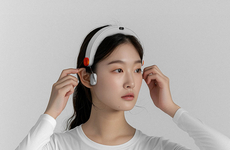
These Glasses Help Visually Impaired People Navigate Their Environment
Rahul Kalvapalle — May 22, 2014 — Tech
References: cinvestav.mx & gizmag
Researchers at the Center for Research and Advanced Studies in Mexico have developed an ingenious pair of glasses can help visually impaired people better navigate their surroundings. The device looks to be the most sophisticated of its kind, and uses a combination of ultrasound, GPS, stereoscopic vision and artificial intelligence to assist its wearer.
The glasses have two cameras mounted on the frame. Camera input is then transmitted to a tablet device that processes the data and provides audio directions to the wearer.
They are also embedded with ultrasound technology that can alert visually impaired people to the presence of both static and moving objects nearby.
Artificial intelligence enables the device to recognize locations, read signs and -- incredibly -- even identify different banknote denominations.
Corrochano and his colleagues have patented the technology and are hoping to have a commercial prototype by August. If they find investors, they will begin mass production in less than a year. The glasses will cost between $1,000 and $1,500.
The glasses have two cameras mounted on the frame. Camera input is then transmitted to a tablet device that processes the data and provides audio directions to the wearer.
They are also embedded with ultrasound technology that can alert visually impaired people to the presence of both static and moving objects nearby.
Artificial intelligence enables the device to recognize locations, read signs and -- incredibly -- even identify different banknote denominations.
Corrochano and his colleagues have patented the technology and are hoping to have a commercial prototype by August. If they find investors, they will begin mass production in less than a year. The glasses will cost between $1,000 and $1,500.
Trend Themes
1. Assistive Technology for the Visually Impaired - Disruptive innovation opportunity: Develop more advanced and affordable assistive devices to help visually impaired individuals navigate their surroundings.
2. Integration of Sensors, AI, and Wearable Devices - Disruptive innovation opportunity: Explore the potential of combining sensors, artificial intelligence, and wearable devices to create innovative solutions for various industries.
3. Accessibility and Inclusive Design - Disruptive innovation opportunity: Emphasize the importance of accessibility and inclusive design in developing products and services that cater to the needs of visually impaired individuals.
Industry Implications
1. Healthcare and Assistive Technology - Disruptive innovation opportunity: Collaborate with healthcare professionals and technology experts to develop cutting-edge assistive technology that enhances the lives of visually impaired individuals.
2. Consumer Electronics and Wearable Devices - Disruptive innovation opportunity: Invest in research and development of wearable devices that integrate sensors, artificial intelligence, and advanced features for enhanced user experiences.
3. Tech Education and Training - Disruptive innovation opportunity: Integrate education and training programs to educate professionals and developers about the importance of accessibility and inclusive design in technology solutions.
2.1
Score
Popularity
Activity
Freshness























